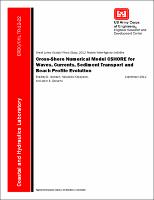Please use this identifier to cite or link to this item:
https://hdl.handle.net/11681/7734| Title: | Cross-shore numerical model CSHORE for waves, currents, sediment transport and beach profile evolution |
| Authors: | University of Delaware. Center for Applied Coastal Research Johnson, Bradley D. Kobayashi, Nobuhisa Gravens, Mark B. |
| Keywords: | Beach erosion Dune erosion Flooding Modeling Morphology Nearshore Sediment transport Storm Great Lakes Coastal Flood Study, 2012 Federal Inter-Agency Initiative |
| Publisher: | Coastal and Hydraulics Laboratory (U.S.) Engineer Research and Development Center (U.S.) |
| Series/Report no.: | ERDC/CHL TR ; 12-22. |
| Description: | Technical report The majority of the world shoreline is experiencing some form of erosion, which will become more serious if the mean sea level rise accelerates because of the greenhouse effect. The recent increase of coastal storm damage necessitates the development of numerical models for predicting the damage progression and breaching of beaches, coastal stone structures and earthen levees during extreme storms. This report summarizes the continuing effort to improve our quantitative understanding of beach morphology and structural damage progression with the goal to develop simple and robust models that are suited for engineering applications. Our effort for the last 10 years has produced the cross-shore numerical model CSHORE, which is presently limited to the case of alongshore uniformity. CSHORE consists of the following components: a combined wave and current model based on time-averaged continuity, cross-shore and longshore momentum, wave action, and roller energy equations; a sediment transport model for suspended sand and bedload; a permeable layer modelto account for porous flow and energy dissipation; empirical formulas forirregular wave runup, overtopping and seepage; and a probabilistic model for an intermittently wet and dry zone for the purpose of predicting wave overwash and structural damage progression. The wet and dry model, which is the latest addition to CSHORE, is calibrated and verified using our 107 small-scale tests for irregular wave overtopping and overflow on a levee as well as 118 Dutch tests for low-exceedance wave overtopping, in which velocities and water depths were measured on the crest and landward(inner) slope of dikes. Finally, the computer program CSHORE is explained to facilitate use and modifications, if necessary. In the near future, CSHORE will be compared with wave overwash experiments and structural damage progression experiments. |
| Rights: | Approved for public release; distribution is unlimited. |
| URI: | http://hdl.handle.net/11681/7734 |
| Appears in Collections: | Technical Report |
Files in This Item:
| File | Description | Size | Format | |
|---|---|---|---|---|
| CHL-TR-12-22.pdf | 2.23 MB | Adobe PDF |  View/Open |